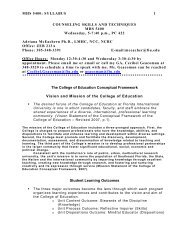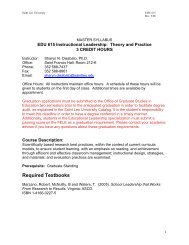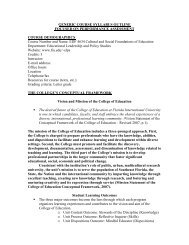2007 - College of Education - Florida International University
2007 - College of Education - Florida International University
2007 - College of Education - Florida International University
You also want an ePaper? Increase the reach of your titles
YUMPU automatically turns print PDFs into web optimized ePapers that Google loves.
Stress Urinary Incontinence in Female Athletes<br />
Kelly I. Daly, Jennifer Doherty-Restrepo<br />
<strong>Florida</strong> <strong>International</strong> <strong>University</strong>, Miami, FL<br />
Objective: The purpose <strong>of</strong> this study is to educate allied health pr<strong>of</strong>essionals and female<br />
athletes <strong>of</strong> the anatomy <strong>of</strong> the pelvic floor, and the pathology, etiology, and prevalence <strong>of</strong><br />
stress urinary incontinence in female athletes. Background: Urinary incontinence is not<br />
a life-threatening or dangerous condition, but it is socially embarrassing, may cause the<br />
individual to remove herself from social situations, and decrease quality <strong>of</strong> life. While<br />
typically associated with parous women who had vaginal delivery, research has shown<br />
prevalence <strong>of</strong> the condition in physically active women <strong>of</strong> all ages. Stress urinary<br />
incontinence has shown to lead to withdrawal from participation in high-impact activities<br />
such as gymnastics, aerobics, and running. It may be considered a barrier for life-long<br />
athletics participation in women. Description: An in-depth introduction to the cause and<br />
origin <strong>of</strong> stress urinary incontinence including review <strong>of</strong> the female pelvic floor anatomy<br />
and prevalence <strong>of</strong> stress urinary incontinence in the female athletic population. Clinical<br />
Advantages: Athletic trainers and other allied health pr<strong>of</strong>essionals will develop an<br />
understanding <strong>of</strong> the multiple mechanisms that cause stress urinary incontinence.<br />
Clinician competency <strong>of</strong> the dynamics and mechanism <strong>of</strong> urinary incontinence prepares<br />
the individual to learn diagnostics, prevention, pharmacological intervention, and<br />
treatment <strong>of</strong> this pathology. Key Words: pelvic floor dysfunction, pelvic floor muscles,<br />
exercise<br />
Urinary incontinence is defined by the <strong>International</strong> Continence Society (ICS) as "the<br />
complaint <strong>of</strong> any involuntary leakage <strong>of</strong> urine". 1 The condition <strong>of</strong> urinary incontinence is a<br />
social or hygienic problem and is objectively demonstrable. 1 There are three types <strong>of</strong> urinary<br />
incontinence: urge, stress, and mixed. Urge urinary incontinence is the complaint <strong>of</strong><br />
“involuntary leakage accompanied by or immediately proceeded by urgency.” 1 Stress urinary<br />
incontinence (SUI) is the complaint <strong>of</strong> “involuntary leakage on effort or exertion” 1 such as<br />
coughing, sneezing, laughing, and exercise. Genuine stress incontinence is urodynamically<br />
proved involuntary loss <strong>of</strong> urine when intravesical pressure exceeds that <strong>of</strong> the urethra without<br />
simultaneous detrusor contraction. 1 Mixed urinary incontinence is the complaint <strong>of</strong> “involuntary<br />
leakage associated with urgency and also with exercise, effort, sneezing, and coughing.” 1<br />
Prevalence<br />
Urinary incontinence is more common in women <strong>of</strong> all ages than in men. 2 “Modern<br />
living conditions coupled with the increased female work force and the desire to keep in shape<br />
through fitness programs result in urologic symptoms representing a high risk to the pelvic<br />
floor.” 3 SUI is the most prevalent type <strong>of</strong> urinary incontinence 2 with prevalence rates between<br />
10% and 55% in women between ages 15 and 64 years. 3,4 Often associated with the older<br />
multiparous women, SUI has been reported to occur in two-thirds <strong>of</strong> female gymnasts 5 and 28%<br />
<strong>of</strong> female collegiate athletes. 6 Data refutes the customary thinking that physically fit women do<br />
not suffer from urinary incontinence, and the participation in sports and fitness activities should<br />
<strong>of</strong>fer protection from this condition. 7<br />
Vaginal delivery is one <strong>of</strong> the highest risk factors 6 for developing urinary incontinence,<br />
but prevalence has been observed and measured in nulliparous physically active females. “It can<br />
occur during various physical activities, but is especially noted in exercise that involves chronic,
















